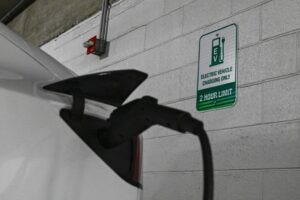NASA’s Climate Change Metrics Need Fixing
Loving your lawn comes with an expensive but unseen cost.
Americans love their lawns. Some clean-looking lawns resemble golf courses in area and may be mowed more frequently than required, a sort of suburban therapy. Cows, cars, and tennis courts are among the targets of climate change agitators. Are lawns and lawnmowers next? Will shaving that gargantuan swath of grass cause the planet to warm
?
NASA’s Spaced-Out View of Lawns
NASA reported back in 2005 that there are “conservatively” three times more acreage of lawns in the nation than irrigated corn. The estimate determined that about 49,000 square miles of US land is mowed for aesthetics. A more recent report from Princeton in 2020 estimates that area is now over 40 million acres (or more than 62,500 square miles).* As for climate impact, NASA’s website reports anthropomorphic lawnmowing activities are not harmful but beneficial:
“[Researcher Cristina] Milesi says that a well-watered and fertilized lawn is a carbon sink [a place that absorbs more carbon than it releases]. If people recycle the grass clippings, leaving them to decompose on the lawn, the U.S. lawn area could store up to 16.7 teragrams of carbon each year. That’s equivalent to about 37 billion pounds — the weight of about 147,000 blue whales. The fact that recycling the clippings on the lawn would be so productive is a little surprising, according to Milesi … After all, decomposing grass is a source of carbon, with bacterial activity releasing carbon dioxide back into the atmosphere. The growth boost provided by the recycling of nitrogen from the decomposing grass clippings more than makes up for the carbon being released.”
This analysis seems to be a tad skewed. NASA measures the weight of carbon dioxide saved in blue whales, but its bizarre calculus ignores the environmental impact of the industrial inputs required to create lawns and grass clippings: gasoline, lawnmower and leaf blower manufacturing, fertilizers, herbicides, pesticides, and the pollution created by transporting clippings. These are “externalized costs” overlooked by NASA in its one-lens, carbon-centric obsession.
Lawn Facts NASA Skipped
Expanding lawn analysis beyond NASA’s narrow carbon-only assessment, the impact of an estimated 800 million gallons of gasoline burned in residential mowers (without pollution-control technologies such as catalytic converters) should be considered: How much energy and carcinogens are released thereby? It is reckoned that at least 17 million gallons of refined gasoline are spilled on the ground each year filling lawnmower tanks – far more than the 11 million gallons of crude spilled by the Exxon Valdez disaster. Lawns are a sink for gasoline as well as carbon: not very nurturing to microbes.
Americans spend billions of dollars on their eye-pleasing lawns, but unseen are the poisons dumped onto grass. Fertilizers cause phosphorous runoff, pollute wells and waterways, and feed algal blooms. Pesticides and herbicides laced with carcinogens kill bees, soil microbes, and other life. Did NASA calculate whether these toxins compromise carbon sinkage? Dead soil does not sequester carbon.
Americans buy some 6 million new lawnmowers annually, including popular “zero-turn” mowers that are anything but net zero. Battery-powered and electric mowers have gained in popularity, but their production comes with a cost. Did NASA consider that? About two million leaf blowers are purchased yearly, an estimated 150 million to be used in America. Leaf blowers are extremely inefficient. A four-stroke lawnmower’s emissions running for one hour are equivalent to an average car traveling 500 miles or running 11 car engines for the same duration.
‘Renewables’ Pollute
(Photo by Celal Gunes/Anadolu Agency via Getty Images)
These same oversights bedevil climate warrior assessments of electric vehicles, solar panels, and industrial agriculture. The astronomical mining and fossil fuel impacts of EVs (including all the fancy gadgets like backup cameras) are simply omitted when only their supposed carbon-sparing benefits are extolled. Most Chinese-manufactured solar panels require coal-burning and extensive mining in their creation. If such costs (along with disposal) were accurately and honestly weighed, these technologies would turn out to be far from “net zero.” All spew toxic chemicals into the air, soil, and water. They are not salvific as advertised but accelerate environmental degradation.
Industrial agriculture destroys soils with chemicals and treats cows horrifically. These abuses are used to target not the anthropomorphic activities of CAFOs (Confined Animal Feed Operations, or factory farms) but their innocent cud-chewing victims. Rotationally grazed cows feed soils depleted and poisoned by tilling (or lawnmowing), creating the most powerful carbon sink possible, while rebuilding eroded lands with manure. No human technology can rival this miraculous soil-nurturing: The resulting explosion of bacteria devours far more methane than cows emit. Healthy, regenerated soils sequester exponentially more carbon dioxide than forests, so “rewilding” is a comparative farce, often reducing net carbon sequestration to sell carbon credit indulgences to corporate schemers while eliminating vital farmlands.
Renewable energy manufacturing is a fraud that creates trillions of dollars in profits for corporations who steer captured government agencies like NASA. Grass blades are God’s renewable energy, using photosynthesis to capture energy and carbon. Grazing cows absorb this energy, stimulate growth (without gasoline spillage), produce manure that nurtures soils, and convert that energy into steaks for dinner. Yet it is cows that are cruelly scapegoated.
No Climate Change Integrity
(Photo by Jessica Rinaldi/The Boston Globe via Getty Images)
Americans may want to do their own environmental calculus rather than be distracted by social justice shenanigans that deliberately obscure the true environmental costs of gadgets and toxic foods peddled as environmentally beneficial. The same culprits who sold Americans on the large, consolidated dairies and industrial farms that destroy the planet are now claiming that only chemical-saturated GMO soils can feed the world (while killing the soil).
Food-producing, soil-building bovines are routinely slandered by the United Nations, World Economic Forum, and PETA, which claim humanity cannot reduce climate change without cutting meat consumption.
India reveres cows – slaughtering a cow is punishable by death in some districts. America worships its lawns (and ritualistic gas-spilling), much as it idolizes anthropomorphic non-renewable technologies above God’s provision of cows on grass. NASA is lost in outer space on climate analysis. Americans should keep their eyes on the ground: Climate change activists who mow their lawns with fossil fuels had best examine the cow-bashing logs in their own eyes.
(Originally published at Liberty Nation.)








Go Cows!
Juniper, Tulip, and Miniature Pearl - our little Jersey herd, are out there cudding it up right now! Our pastures’ seed banks are slowly revealing themselves, and we made it through the drought (barely!) because of they’ve been rotating through, completing their ecological cycle. Go Cows!